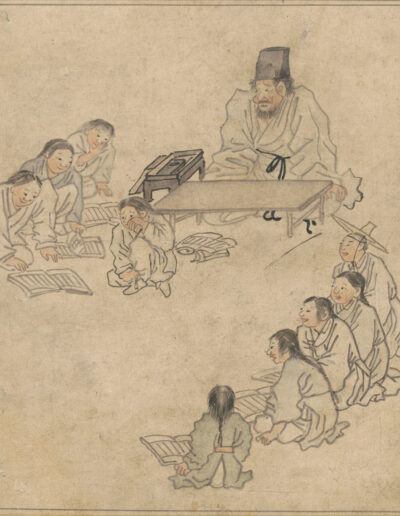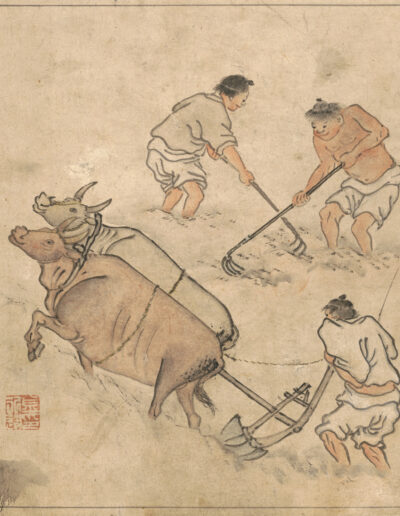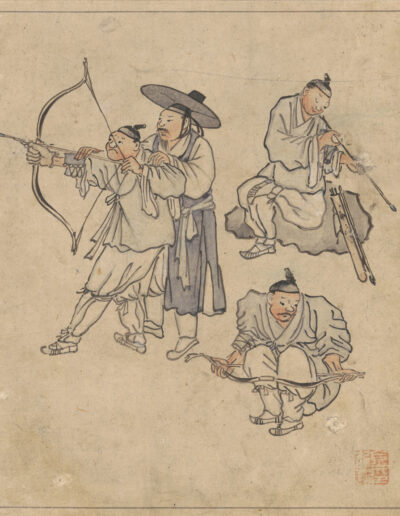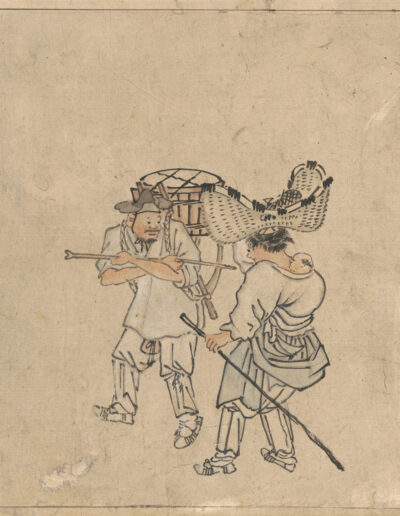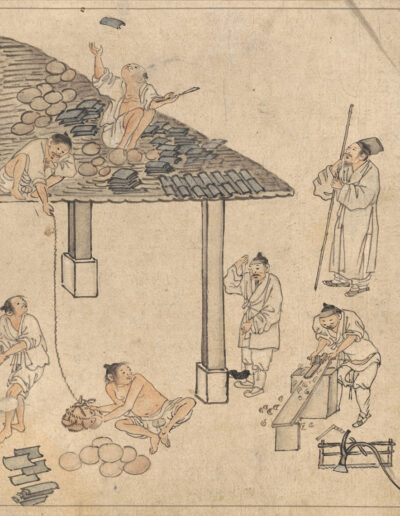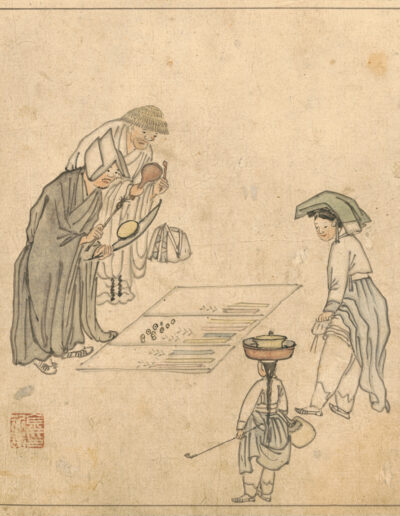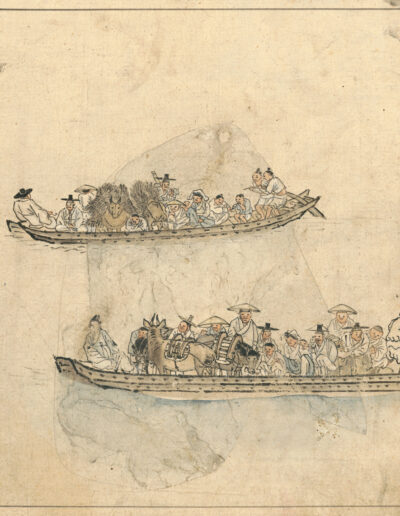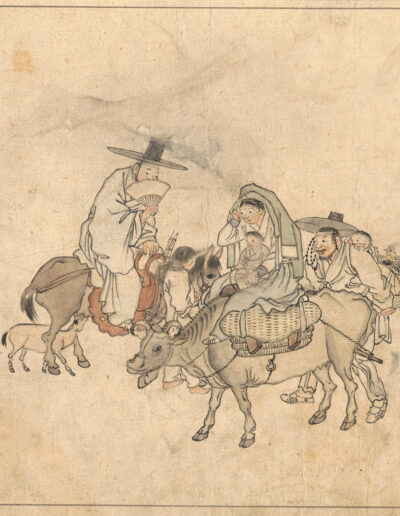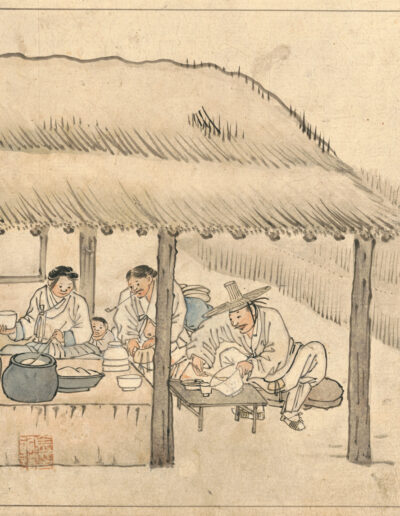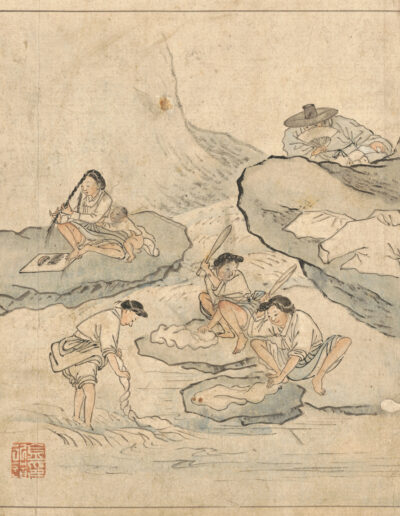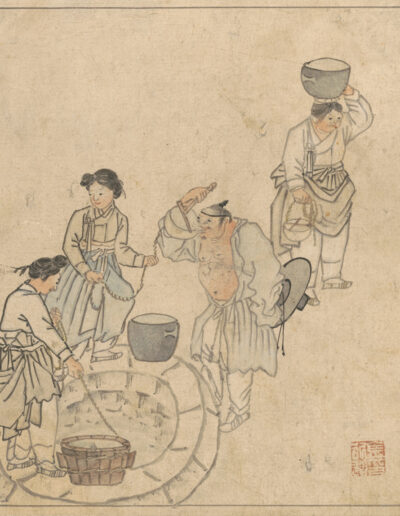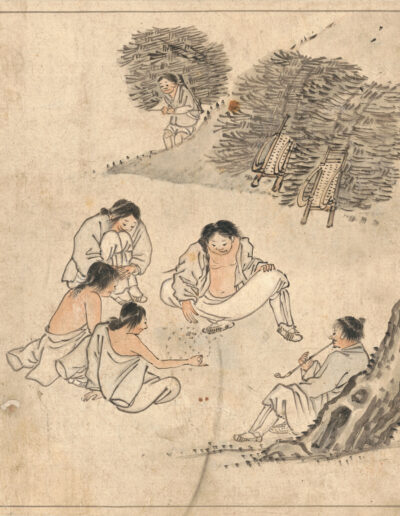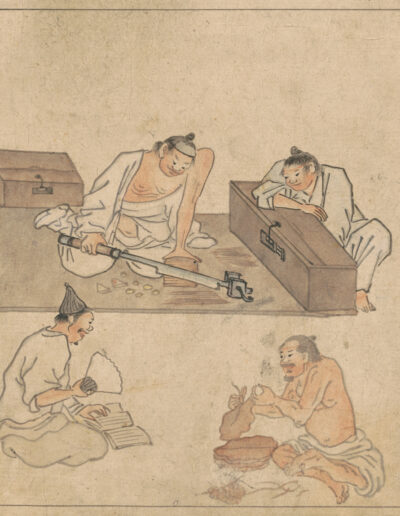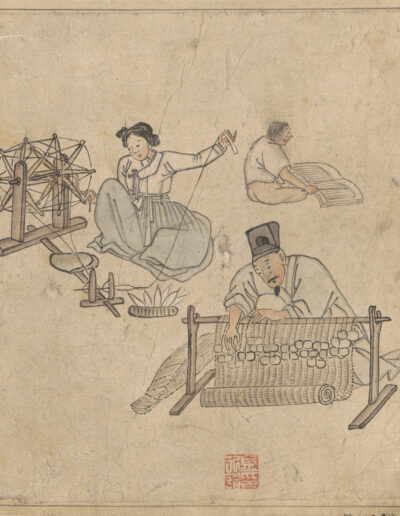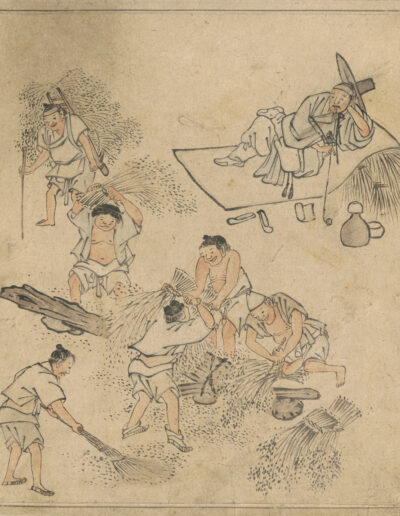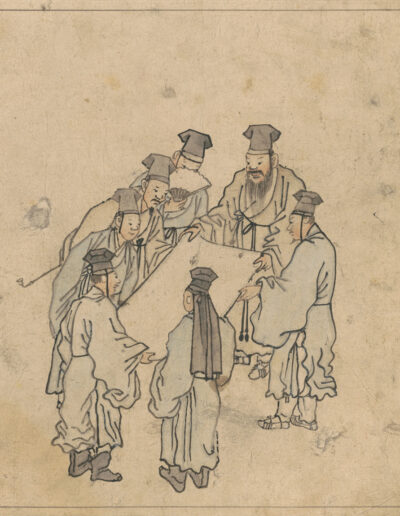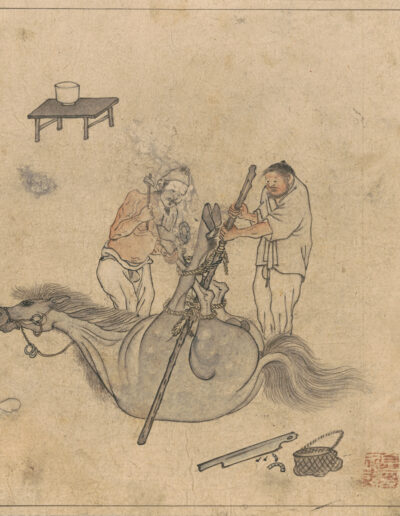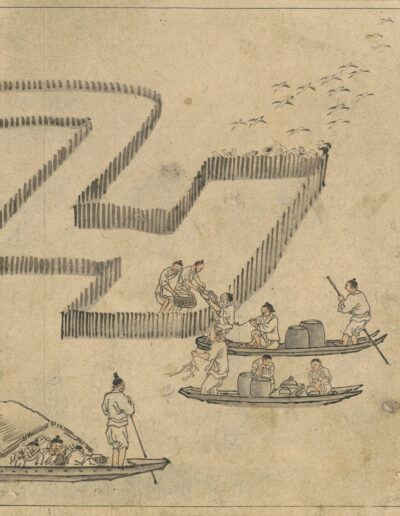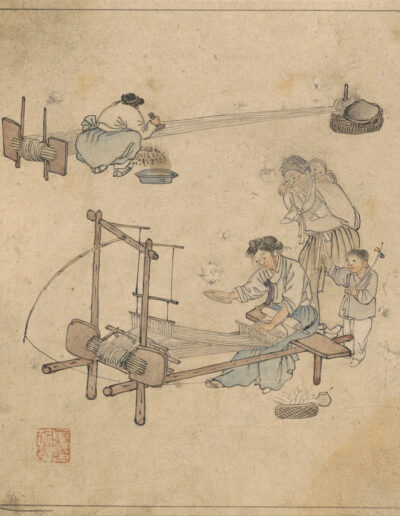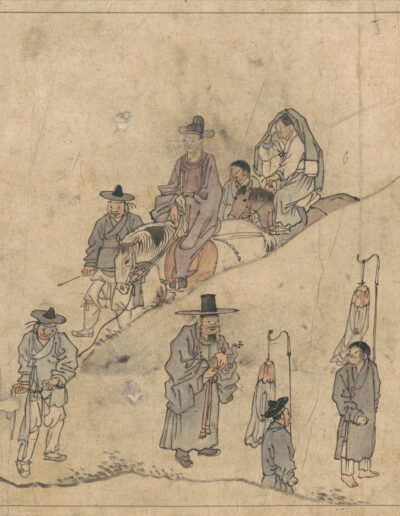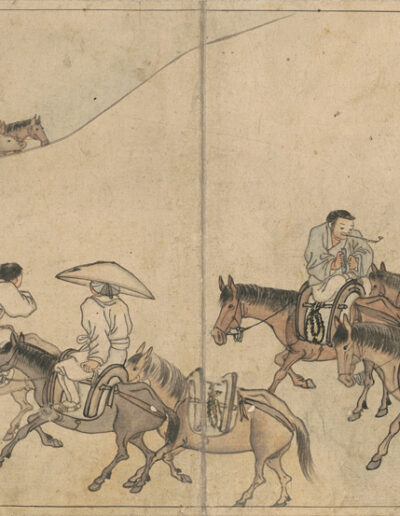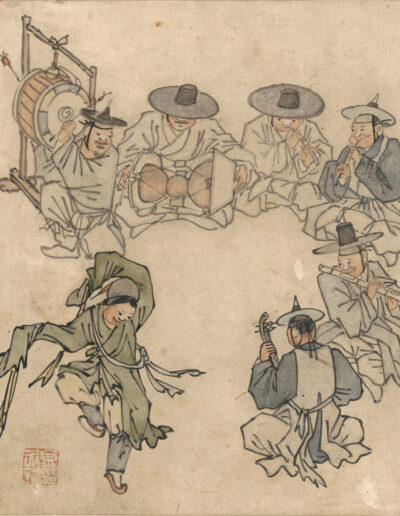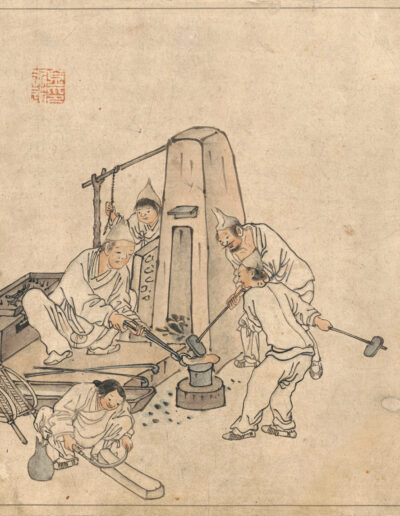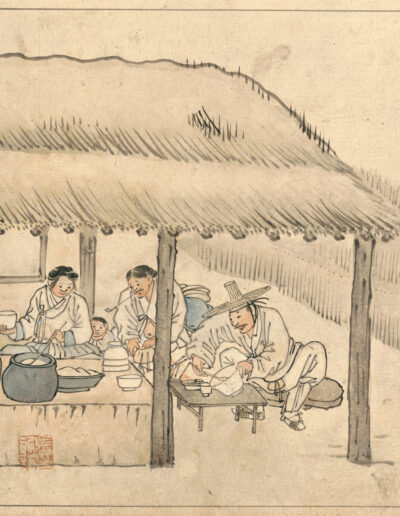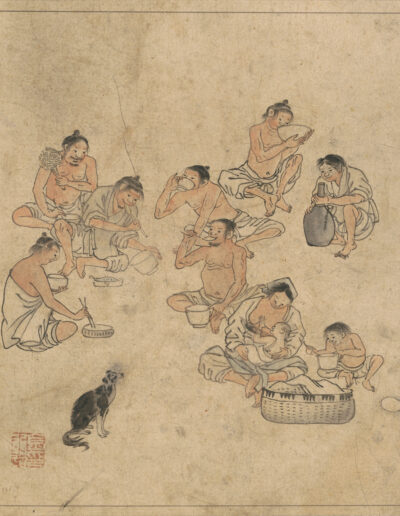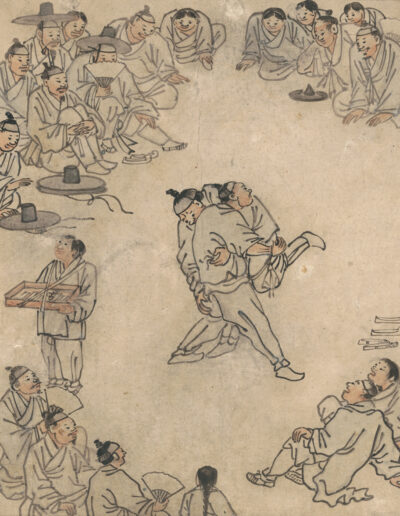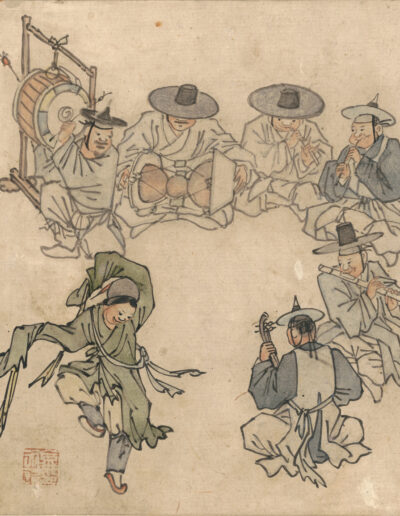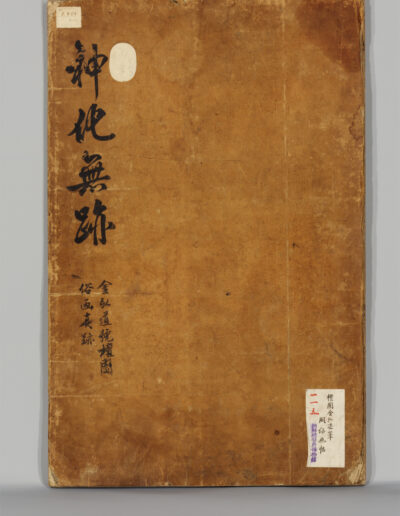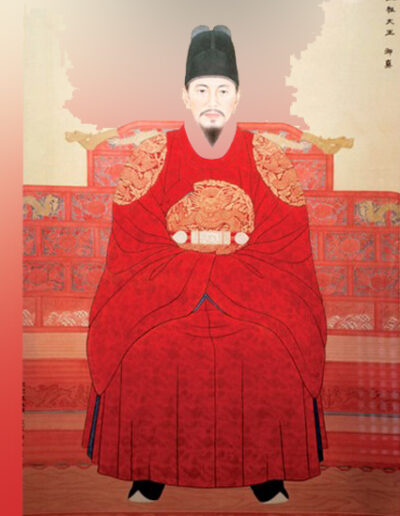Genre paintings album by Kim Hong-do
1785-1795
About the Object
Story of the Object
Teaching suggestions
Classroom Extras
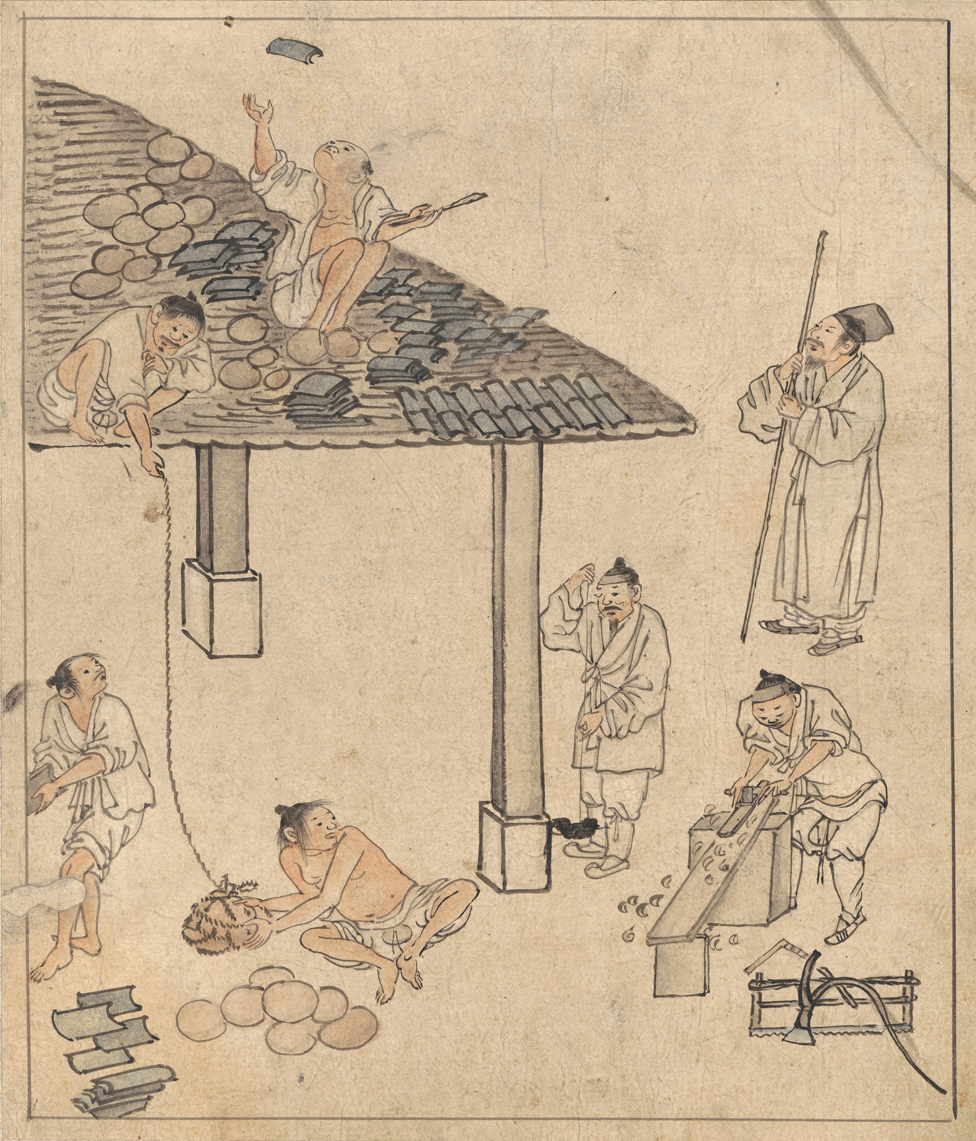
Tiling a Roof ©National Museum of Korea
The album of genre paintings by Kim Hong-do
The genre paintings of the Joseon period produced by Kim Hong-do are some of the most important paintings by a Korean artist.
In all there are 25 paintings of daily life of ordinary people, and they are contained within a single album.
They cover a range of jobs, including jobs linked to working on farms. They also show household tasks, such as washing clothing and taking water from a well, and leisure activities, including archery and going out for a picnic.
They also show other scenes such as the village school, students appreciating a painting, and collecting for chariety.
The paintings are important because they depict ordinary people doing ordinary things, and not just the wealthy and powerful.
In this way, these paintings help to reveal life for most people in the Joseon period at the end of the 18th and start of the 19th centuries.
They were painted by Kim Hong-do, who became the court painter to two of the Joseon kings – King Yeongjo (reigned 1724–1776) and King Jeongjo (reigned 1776–1800).
Kim Hong-do was appointed to this role at the age of 21 in 1766 and it is believed that he painted these pictures of daily life when he was much older, between 1785 and 1795.
The original paintings are held by the National Museum of Korea, though several copies are in existence.
One album is in the British Museum in London, and it is thought that this was produced sometime in the 19th Century.
In 1970, the original album of paintings was designated as National Treasure of South Korea No. 527 under the title of “Danwon-pungsok-hwacheop” which means the Album of Genre Paintings by Danwon, which was the art name taken by Kim Hong-do.
History of the album of genre paintings
The genre paintings of Kim Hong-do appear to have been produced at a time when there was an increasing interest in the lives of ordinary people.
This was accompanied by an interest in showing their lives in pictures to record what life was like at that time in Joseon Korea.
Genre is a French word meaning ‘kind’ or ‘variety’ and from the 18th century, French writers used the phrase “genre painting” to describe paintings of everyday life.
This was very much in contrast to traditional paintings which focused upon scenes from the past, religious subjects, official portraits, landscapes and still-life.
In Europe some painters had already painting scenes from everyday life.
For example, in the Netherlands in the 16th century, Pieter Bruegel the Elder painted peasants who were enjoying lots of different activities whilst ignoring everything else that was going on around them.
In 18th century Britain, William Hogarth also focused upon the lives of ordinary people. His work showed Beer Street and Gin Lane, where he warned of the dangers of drinking lots of alcohol.
Similar paintings existed in Korea before the 18th Century, but these tended to focus upon the lives of the yangban or literati (the ruling elite) and they gave an idealistic view of their lives.
However, in the 18th century the focus moved from the wealthy and powerful to the common people, the workers and the poor.
There was a desire to paint the lives of the ordinary people and it appears that the ruling classes were in favour of this.
At the same time, King Yeongjo encouraged painters to be more lifelike in their representation of individual people and to show their emotions.
And King Jeongjo is recorded as saying in 1789 that painters should, “paint pictures to make people fall over in laughter”.
As a result, genre painters focused much more on the lives of ordinary people, their actions and reactions.
Kim Hong-do proved to be one of the most famous and effective of the genre painters of late 18th century Korea.
Kim Hong-do
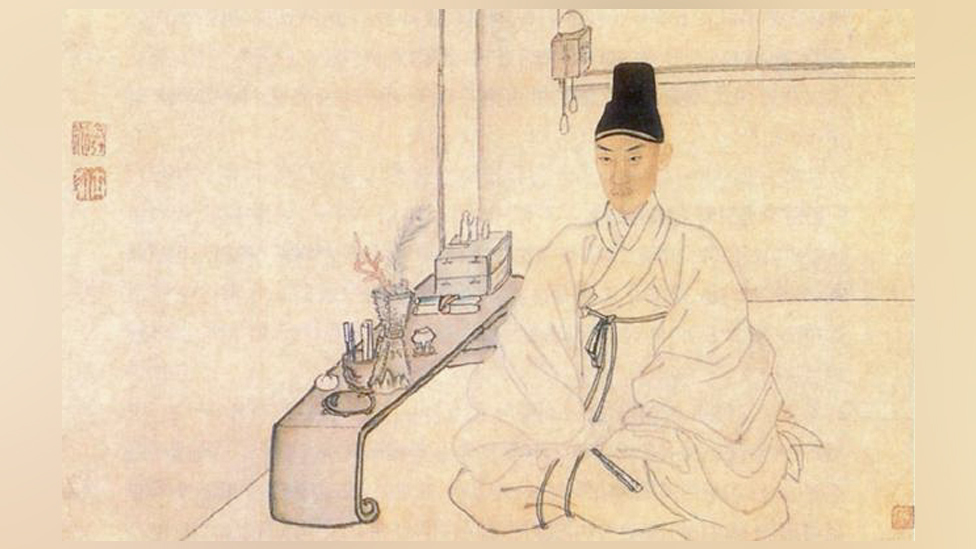
Kim Hong-do (Source: Heritage Channel)
Kim Hong-do was born in Ansan, Korea, in 1745.
When he was seven years old, Kim began his painting studies under Kang Se-hwang, a famous Korean painter and calligrapher, who also lived in Ansan.
In 1766, on the recommendation of Kang Se-hwang, 22 year old Kim Hong-do was appointed to be a member of the Dohwaseo, the name for the group of official painters of the Joseon court.
Over the next ten years he became a skilled artist, painting the portrait of the future King Jeongjo, and assisting in the painting of King Yeongjo in 1773.
His reputation was strengthened enormously in 1776 when he painted the ‘Nineteen Taoist Immortals’, which showed mortal beings attaining immortality and supernatural abilities.
By then he was referred to as the artist ‘Danwon’.
Although he is remembered for his wonderful genre paintings of daily life of ordinary people, he was a master of many painting styles.
He became the favourite court painter of King Jeongjo who commissioned him to paint official events, such as the Welcoming Banquet for the Governor of Pyeongan’ (sometime after 1776) and The Gathering of the Elders in 1804.
The Welcoming Banquet for the Governor of Pyeongan consists of three paintings welcoming the newly appointed governor and shows two daytime banquets at separate pavilions and a procession of boats on the Daedong River in the moonlight.
As noted by the National Museum of Korea, the three panorama paintings are “masterful documents of these events, filled with extraordinary intricate details: the sprawling crowd at the Daedong riverside, the meticulously depicted buildings and fortress, the dazzling gilt and splendid colours of the flags, and the myriad of individual features of the people attending the banquet, from the torchbearers to the ordinary onlookers”.
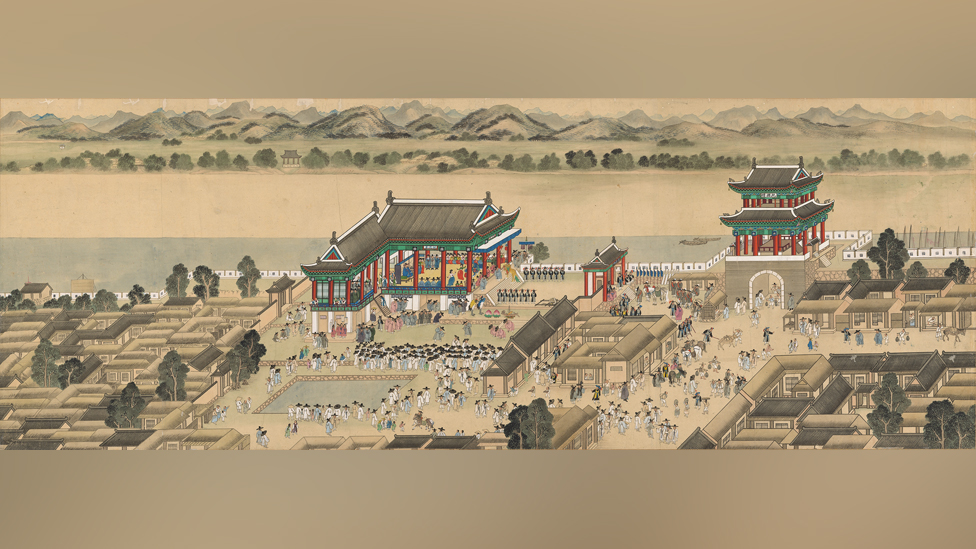
Welcoming Banquet for the Governor of Pyeongan © National Museum of Korea
The Gathering of the Elders is similar in style in that it is full of people arriving and participating at an official meeting.
He also painted landscapes, the natural world and portraits.
During his lifetime Kim Hong-do’s paintings were extremely popular.
His mentor, Kang Se-hwang noted that: “So many people wanted one of Kim’s paintings that they crowded his doorway, bringing piles of silk, and making him so busy that he didn’t have time to eat or sleep”.
Reference: Album of Genre Paintings by Danwon, Kim Hong-do (National Museum of Korea, 2010-10-28)
Despite this popularity, like many artists, Kim Hong-do did not seek riches. It appears that he spent what money he had unwisely, and he died in poverty sometime between 1806 and 1814.
Kim Hong-do was immensely talented, and it has been calculated that he produced over 750 separate works during his lifetime.
However, he is best known for his album of genre paintings.
The scenes of daily life depicted in the album of genre paintings
The album of genre paintings contains 25 separate works and most of them measure no more than 28cm by 24cm.
They were painted when Kim Hong-do was in his forties, and it is thought that he had developed the style adopted in the paintings when he was in his thirties.
The topics covered are as follows:
1 – A village school
2 – Ploughing a rice field
3 – Archery
4 – Peddling
5 – Roof tiling
6 – A blacksmith’s workshop
7 – Alms gathering
8 – Two boats
9 – Going out for a picnic
10 – A Tavern
11- Washing the laundry
12 – A well
13 – Playing Gonu
14 – Shredding tobacco leaves
15 – Weaving a mat
16 – Rice threshing
17 – Appreciating a painting
18 – Shoeing a horse
19 – Fishing
20 – Weaving
21 – On the way to a wedding
22 – On the way to a market
23 – Lunch time
24 – Wrestling
25 – A Dancing Boy
This list shows clearly the various aspects of daily life which are depicted, and his main subjects were working-class people who were generally ignored in paintings by other artists.
The themes of the paintings can be identified as:
- places of work, such as the blacksmith’s smithy,
- daily tasks, such as doing the laundry,
- life on the street, such as on the way to market,
- recreational pastimes, such as wrestling, and
- education, such as appreciating a picture.
One of the most important features of the paintings is that there is no background to the scene being depicted. The focus is upon the tasks in hand, the actions of the people shown, and their facial expressions.
This means that Kim Hong-do was interested not in any surrounding natural landscape but in the actions of the people and the situations in which they found themselves.
During a period when genre paintings usually showed people without any emotions, Kim Hong-do was a forerunner in the new wave of the Joseon Dynasty by showing facial expressions.
In addition, he often depicted humour as well as reinforcing what was important to the Korean people.
As a result, the paintings are honest in what they show, and the colouring enables the viewer to study the whole picture rather than be focused on one aspect.
Furthermore, his genre paintings help us gain an insight into the politics and economy of the late Joseon period, as well as the social structure, customs, manners and even morals of the people shown.
He even went so far as to amend the state examination for royal painters to ensure that in future all applicants had to produce a genre painting.
Kim Hong-do’s style and skill are best understood by looking at his paintings in the album in some depth.
Below are some details from four of the paintings but it would be useful to look first at this video which explores what is depicted in the album:
A Dancing Boy
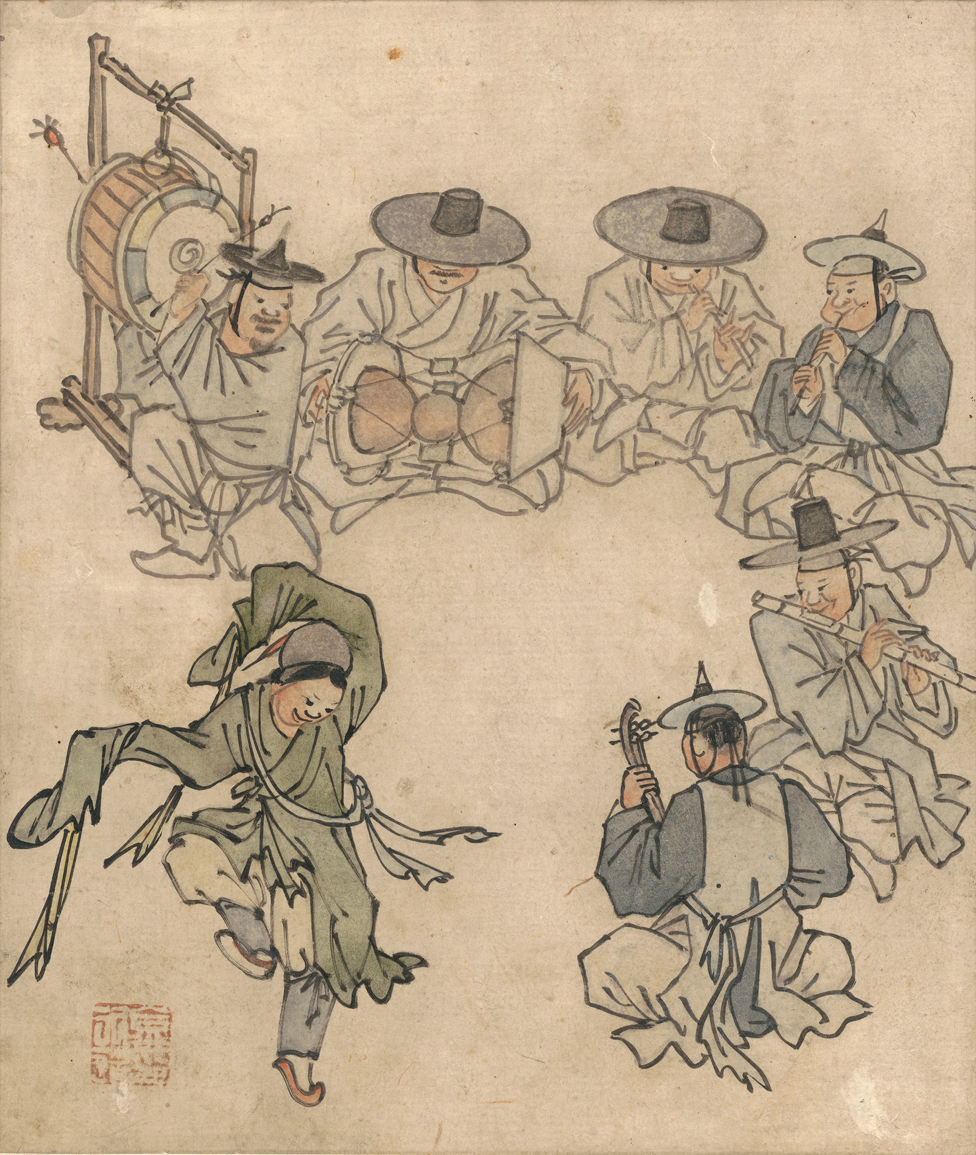
The Dancing Boy © National Museum of Korea
In this painting, Kim Hong-do shows the enjoyment of the Korean people in music and dancing.
There is no special background, so you are drawn to the people themselves, namely the boy dancer and the six musicians.
Where faces are shown, the musicians can be seen pursing their lips to blow the instruments and the boy’s expression. The placement of his arms and the movement in his clothes seem to show an energy and him being engrossed in his dancing.
The musicians are seated in a semi-circle, allowing them to watch and connect with the boy through sound, movement, and eye contact. The six musicians are playing Samhyeonyukgak music which is a traditional style of music performed by six musicians.
The instruments played are the buk (drum), janggu (hourglass-shape drum), hyangpiri (flute), sepiri (small flute), daegeum (large flute), and haegeum (Korean fiddle).
A Village School, or Seodang
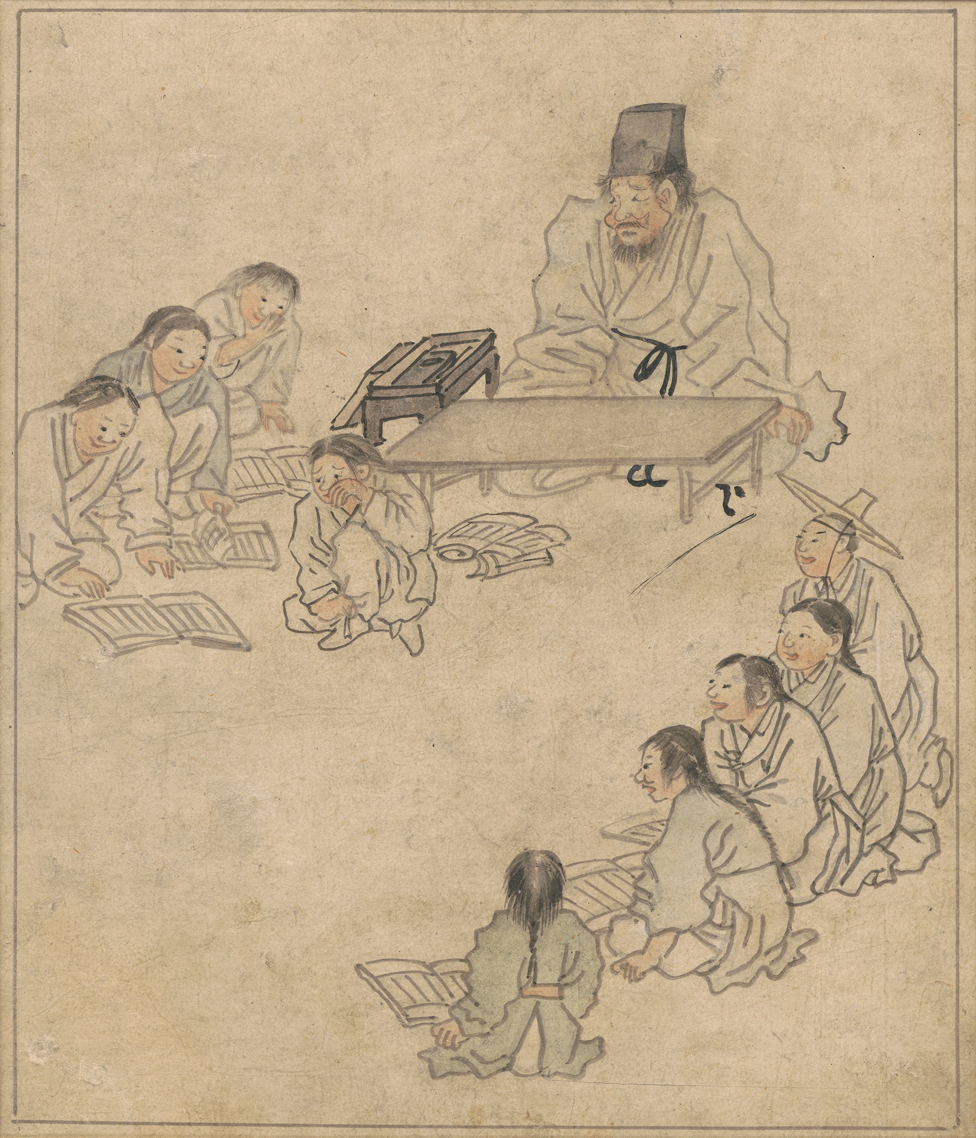
A Village School © National Museum of Korea
In this picture there is a teacher and nine students in a lesson. At the heart of the painting is a young student with his back turned to his teacher and he appears to be crying.
Given their facial expressions, it appears that the other students find this situation amusing.
The teacher is sitting behind a table on which there are no papers suggesting that he is experienced and requires no notes. He is wearing a square hat known as a banggeon.
The position of the cane next to the table and the action of the crying boy in holding the leg of his trousers at the ankle suggests he is about to roll up his trousers so that he can be caned.
The stern face of the teacher shows his determination to carry out the punishment.
Weaving a Mat, or Jari Jjagi
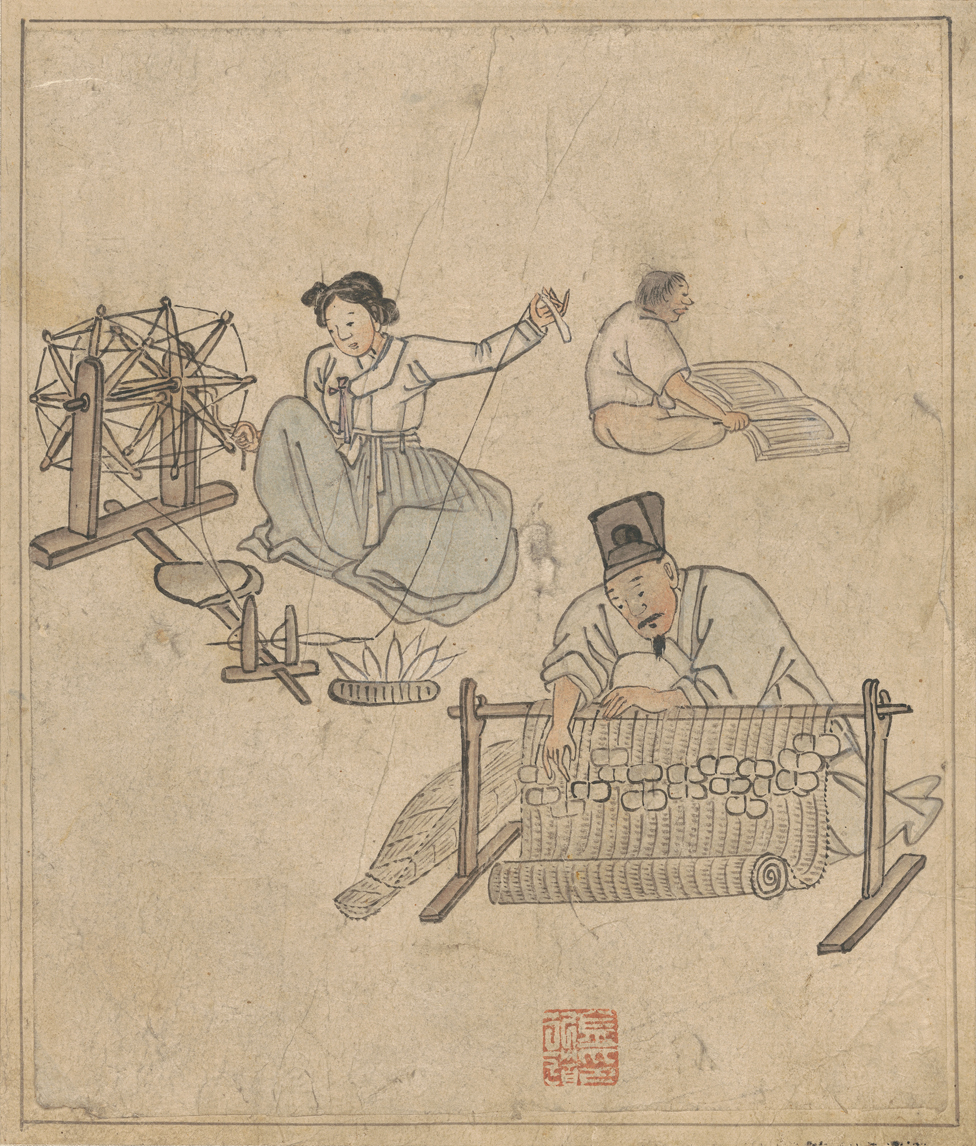
Weaving a Mat © National Museum of Korea
The theme of learning is also seen in this painting. In this family scene, the focal points of the painting are the mother who is spinning and the father who is weaving.
However, in the background the son has his back to his parents, but he is reading a book and appears to be pointing out the letters as he reads aloud.
The faces of the parents show them to be content and it is suggested that this is because their son is learning, they are enjoying their work and they are happy in the knowledge that their son will be successful because he is learning.
The Tavern, or Jumak
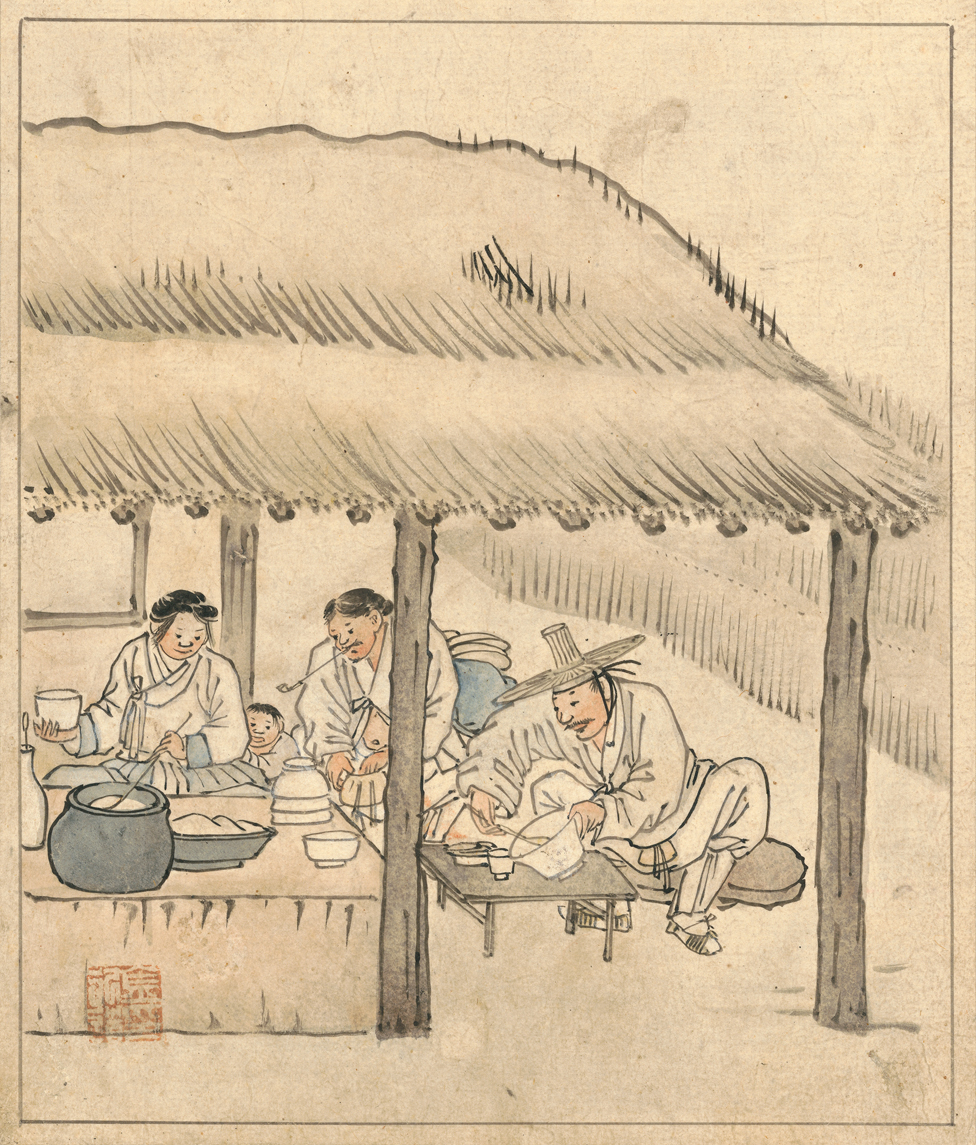
The Tavern © National Museum of Korea
Here, a traveling couple are satisfying their hunger and thirst at a tavern.
There is action in the painting in the way the man is leaning forward and tilting the bowl, so he can have all that is in it.
This suggests that he is hungry. In general, though, the picture gives a vivid depiction of taverns at that time with the lady ladling out drinks for her customers and with various dishes placed on a cooking platform.
Beside her is her child watching what is happening and showing how important this business was for her and her family
The importance of the album
The genre paintings of Kim Hong-do comprise a unique insight into everyday life of the common people in the late 18th and early 19th centuries in Joseon Korea.
The style he adopted gives his pictures a distinct status, one in which the scenes are dynamic and invite the viewer to take a closer look.
The paintings do not show the wealthy or famous but instead reflected everyday activities.
They also depict what was important for the Korean people, such as music, dancing and most of all learning.
‘A Village School’ is one of Kim Hong-do’s most popular paintings, not least because education and learning are highly regarded across all classes of Korean society.
Classical Korean scholars regarded learning as one of the utmost pleasures in life, and today Korean families invest much money and time in their children’s education both at school and at home.
Some paintings reveal activities which were well known but the methods used are different and which people in Europe would find somewhat surprising.
In ‘Shoeing a Horse’, the animal is seen lying on its back with its four legs tied together and to a post to prevent it from moving and thus allowing the blacksmith to attach the shoes to the hooves.
Careful study of the paintings reveals humour as in ‘Washing the Laundry’ in which a man is shown spying on women washing clothes in a stream from behind a rock.
His face is hidden behind a rock as he looks at the women, all of whom are partially undressed for the tasks in hand and have bare legs so that they do not wet their clothes when they enter the water.
The paintings open a window upon Korean society and especially of the ordinary people. By openly depicting the times in which he lived, Kim Hong-do helped viewers at the time and since to better understand Korean culture.
Kim Hong-do’s genre paintings are the basis of his claim to fame as one of the most important painters of the Joseon period.
However, he was immensely versatile and was also known for his great skill in painting landscapes, religious themes, birds, flowers, animals, portraits and, as court painter, official events. He was, indeed, an artist of many talents.
Under his pen name, Kim Hong-do is remembered as one of the Three Wons. Together with Shin Yun-bok (1758-1813), whose pen name was Hyewon, Jang Seung-eop (1843-97), who was known as Owon, Kim Hong-do, as Danwon, the Three Wons are regarded as some of the most significant artists in the history of Korean painting.
His genre paintings are a most important contribution to Korean art and culture, and were recognised as such at the time and since.
In the words of Kang Se-hwang, Kim Hong-do’s painting tutor, “those who witnessed his work could not fail to cry out and clap in wonder at each brushstroke”.
Reference: Eleanor Soo-ah Hyun, Work and Leisure: 18th Century Genre Painting in Korea (Department of East Asian Languages and Cultures, Columbia University, October 2004; article extracted from the NMK Magazine, Vol.05.
Retrieval practice
1. In total, how many genre paintings of daily life of ordinary people are included in the album by Kim Hong-do?
a) 25
b) 50
c) 75
2. Where are the genre paintings of Kim Hong-do kept?
a) The British Museum in London
b) The Louvre in Paris
c) The National Museum of Korea in Seoul
3. When was Kim Hong-do born?
a) 1645
b) 1745
c) 1845
Where else in the world?
Ask pupils to research important events from this time. This could have a Korean focus, or it could be expanded to give a global perspective.
You might want to widen the period of study to the whole of the later-eighteenth century.
For example, in France, this is the time of the French Revolution (1789), and in Europe this era is widely considered as transitional between the Age of Enlightenment and the Industrial Revolution.
Over in America, this was a time of revolution – the American Revolutionary War ran from 1775 to 1783.
Genre paintings from around the world
For example, in the Netherlands in the 16th Century, Pieter Bruegel the Elder was known for painting large crowds of peasants enjoying themselves.
Later, William Hogarth focused upon the lives of ordinary people and in images called Beer Street and Gin Lane’ Here, he depicted the popularity and dangers of excessive alcohol drinking.
Ask students to research the work of one (or both) of these artists. Also, there are other Korean and Japanese genre artists. For example, notable Korean painters include Sin Yun-bok and Kim Deuk-sin, whilst Japanese printmakers include Katsushika Hokusai and Utagawa Hiroshige.
What's the theme?
The Album of the Genre Paintings is a remarkable depiction of what daily life was like in 18th Century Korea.
Why not get your pupils to work out what the main aspects or themes of daily life are shown? Provide them with a selection of paintings which are now easily downloadable. Between 6- 12 paintings would be good number.
Then, in pairs or groups, ask them to analyse each painting and work out what aspect of life each painting is depicting. Task the with coming up with a title or a name for each painting.
You can then reveal the titles to them to see if they agree with them or not. You can find the names / titles here.
Once they have worked out the names, ask them to classify the selection of paintings into different groups such as:
- Work
- Daily Life
- School
- Hobbies
Create a mini exhibition of the paintings
Put your pupils in the role of an art gallery/museum curator.
Their job is to prepare for an exhibition of genre paintings.
You could ask them to research The Album of Genre Paintings, select 4 / 6 / 8 paintings for their exhibition and then write a didactic (blurb to accompany) for each painting to give it context and explain what it shows to the visitors.
The didactics could include:
- Title
- Brief description of the scene
- Background and purpose
- Date
Write an online encyclopaedia entry for Kim Hong-Do
The artist Kim Hong-do is an important historical figure.
Why not ask your pupils to research Kim Hong-do’s life and research and write an online encyclopaedia entry about him?
It is a good idea to structure their research and give them a specific word count to limit how much they can write. This adds challenge.
Pupils could work individually, in pairs or in groups.
You could use these headings to structure their research and then help them to write their entries:
- Early life
- Life as a painter
- Legacy
Classroom Extras
Here you will find a number of images, video clips and website links which can be used as extras for teaching in the classroom or for use by pupils undertaking independent research.
Images
Study these images of the Genre Paintings:
Map
Select Google Maps options to view key locations for different objects:
Videos

Discover more online
Wikipedia: Kim Hong-do
Wikipedia: Danwon pungsokdo cheop (The Album of Genre Paintings by Danwon)
Google Arts and Culture: Kim Hong-do and his paintings – here you will find images of many of his paintings
National Museum of Korea: Album of Genre Paintings by Danwon, Kim Hong-do
National Museum of Korea: The full album with commentary on each of the 25 paintings
British Museum: A copy of the album of Genre Paintings
Academy of Korean Studies – Centre for International Affairs – Understanding Korea Materials: Info Korea 2015 Articles: Paintings of the Joseon Period, and Beautiful and Charming Old Korean Paintings
Smart history, The Center for Public Art History: Article: Kim Hong-do, album of genre paintings by The National Museum of Korea
Department of East Asian Languages and Cultures, Columbia University, October 2004: Article: Eleanor Soo-ah Hyun, Work and Leisure – Eighteenth Century Genre Painting in Korea

